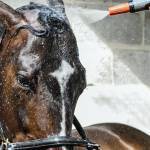Relinquish the Sweat Scraper to Best Cool Horses

If you want to start a heated discussion among equine enthusiasts, ask the best way to cool a horse after exercise. Chances are, most will agree that actively cooling the horse with cold water is the best place to start. After that, though, the conversation may rapidly devolve when you ask whether to leave the water on the horse or scrape it off?
The main mechanism horses use to thermoregulate (maintain an appropriate internal body temperature) is evaporation. In exercising horses, sweat evaporates from the skin to facilitate cooling. If horses are actively cooled with water, then some caretakers believe that the water will trap heat against the skin unless it is removed by scraping. Others believe that leaving the water will help cool the horse by an alternate method called heat conduction.
In an effort to learn more about thermoregulation, Australian researchers used both cooling methods after exercise and compared the central and rectal temperatures in five horses.* Each horse was exercised on a treadmill in hot and relatively humid conditions (about 27° C [80° F] and 50% humidity). After exercise, horses were then actively cooled by applying 8 gallons (30 liters) of cold water to the horse each minute for six consecutive minutes. The water was either scraped off after each application or the water was left in place.
“Compared to horses that did not have direct water application after exercise, the body temperatures of horses that were actively cooled decreased significantly regardless of scraping,” explained Catherine Whitehouse, M.S., an advisor for Kentucky Equine Research.
In other words, direct water application decreases a horse’s body temperature whether or not the water is scraped off between applications.
“The data also showed that greater reductions in body temperature were observed when the water was not scraped off between applications,” Whitehouse added.
The researchers concluded “that constant contact with water is more important for heat conduction and more effective than producing and using sweat evaporation to remove heat.”
Many regions of the world with large horse populations achieve or exceed the high temperatures and humidity used in this study. Because of this, these horses require active cooling after training or competition to avoid heat stress or exertion-related illness.
And with all that bathing, owners need to be cognizant of the heath of the horse’s skin.
Whitehouse said, “In addition to a well-balanced diet, owners should use high-quality products to provide key nutrients for the maintenance and repair of healthy skin. For those horses with stubborn skin problems, like rain rot or scratches, consider using a marine-derived oil high in omega-3 fatty acids, such as EO-3.”
She also noted that when cooling off a horse after exercise or bathing it is important to remove all traces of sweat and residual soap to help maintain skin and coat health.
*Kang, H., R.R. Zsoldos, J.E. Skinner, J.B. Gaughan, and A.S. Guitart. 2021. Comparison of post-exercise cooling methods in horses. Journal of Equine Veterinary Science:103485.








